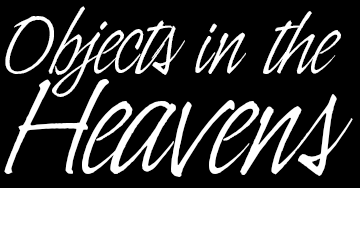



by Robert Prokop (website)
Amongst the most impossible questions to answer at a star party is "What is the best telescope? Which one should I buy?" Of course the best answer to that imponderable is "The best telescope is the one that you'll use." Well.. the same thing goes for handbooks, manuals, and star charts. The right question to ask is "Am I going to use this?" And as regards Peter Birren's Objects in the Heavens, the answer is an unqualified YES.
I saw this book advertised in The Reflector magazine and was sufficiently intrigued to check out the website. What I saw there convinced me it was worth a try, so I ordered a copy. I have to say it arrived in near record time.
First of all, the externals. The book measures 8.5X5.5 inches, so it is a very convenient size (unlike the mammoth 2 volume Night Sky Observer's Handbook published by Willman-Bell, my go-to reference guide). I like the spiral binding - allows the pages to lay flat with nothing lost in the fold. I haven't taken it out in the field yet, but the paper does not appear to be dew resistant, so you might want to take precautions against it getting damp. The author uses his own idiosyncratic symbols for various objects, but I quickly got the hang of it, and found some of his innovations rather useful (such as making the distinction between binocular and telescopic objects). The star charts are for illustrative purposes only. The book might be best used in conjunction with Sky and Telescope's Pocket Sky Atlas.
Objects in the Heavens is divided into 3 major sections. The first is a very fine reference/introduction aimed at a novice audience. It's amazing how much is covered in such a small space (40 pages). It would be exhausting just to list the topics covered. Everything from explaining how various types of telescopes work to what is meant by right ascension and declination to a quick tutorial on how we got the constellations as they now exist, and literally dozens of other subjects as well.
Seven pages of the introduction are dedicated to the Moon. This is probably the weakest section in the book, but it's hard to see how it could have been otherwise. The Moon really requires a book to itself to do justice to the challenges of observing it. But I do give Mr. Birren credit for dividing his treatment of the subject by days after new moon. So he has a list of the major features sitting atop the terminator for each day. Unfortunately, the accompanying illustrations are just too small to be useful on their own. For the most part, I have no quarrel with the features he chose to highlight.
The introduction ends with 4 very attractive charts, one for each season.
The meat of the book is Section Two, a constellation-by-constellation listing of Deep Sky Objects (magnitude 10 or brighter) with brief, often amusing, descriptions of what you're looking at, accompanied by a chart of the constellation itself. The introduction says there are 830 objects identified in this book - enough to keep most stargazers busy for several years, if not a lifetime. I like the balanced nature of Birren's listing. It's not top heavy with galaxies or overly dominated by open and globular clusters. There are nebulae galore and enough double stars and even singleton stars to satisfy even a fanatic like myself. (Almost! I checked for some of my favorites, and was sad to find many of them them missing. But come on, there are countless thousands of the things up there viewable through the average telescope. So if Struve 2398 (one of my favorites) was omitted, I can't really complain now, can I?
I was pleased to find Barnard's Star listed, but disappointed to not see Lalande 21185 in Ursa Major. What gives, Peter? How did you miss that one? (Note from the author: this carbon star has now been added. Thanks for the note about this star!)
But on the flip side, there are more than enough listings that I had never heard of, which just goes to show that any list compiled by a single individual will never match another's. And that's a good thing.
The constellations are listed alphabetically and not in the order they appear in the seasons, just as they are in the Night Sky Observer's Handbook.
The final section is enough space to record 15 sketches of your own observations. You can order separately a second volume entirely devoted to sketching. (I did not, so I cannot comment on it.) I heartily endorse the author's maxim: "Trust nothing to memory!" Good advice.
Bottom line? Objects in the Heavens is value for money, and I will definitely be consulting it when planning future nights out under the stars.